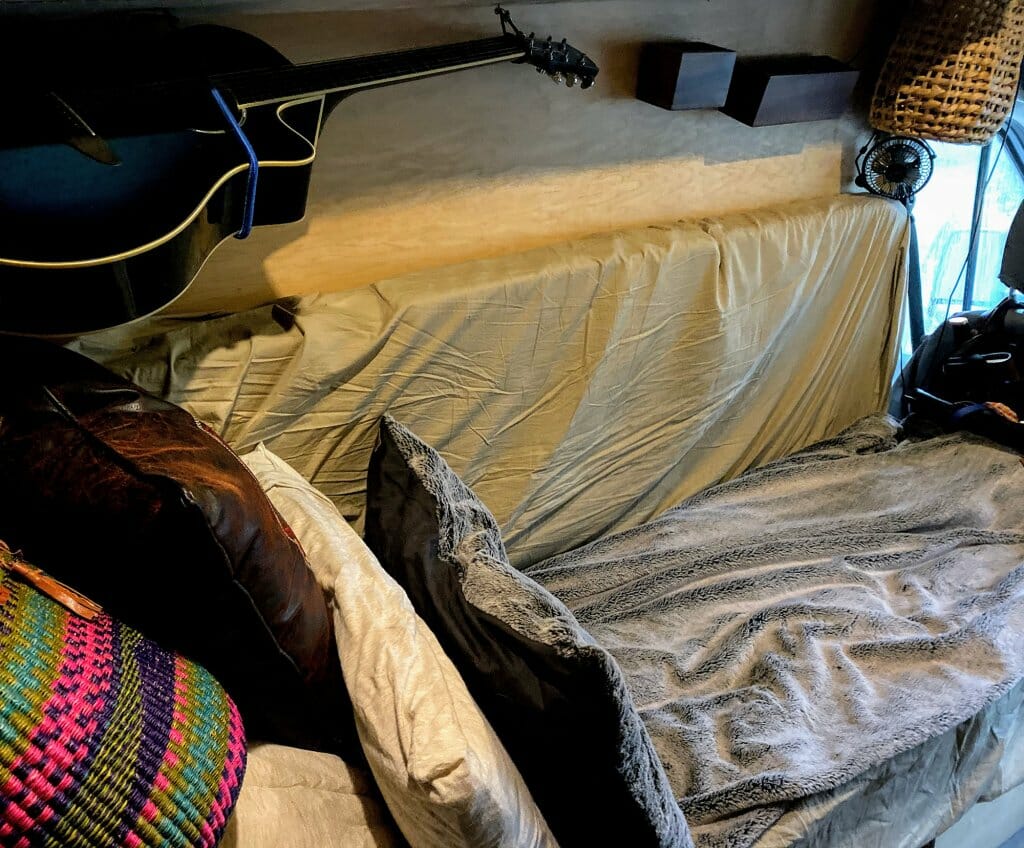Most vans I see have a similar layout: the bed at the back, and the kitchen near the sliding door on the side. I don’t like this layout because, even though the area beneath the bed is used for storage, it closes off half of the van. The bed cannot be converted, like with a sofa bed. There’s very little room to sit inside on a rainy day. You can’t walk from the front to the back of the van.
I built my wood-cabin steampunk van to have a sofa facing the sliding door, which pulls out to a full bed. At first, I tried using the smallest Ikea couch/sofa-bed I could find. But this wasted far too much space (due to awkward angles), and it was hard to convert the couch into a bed because of the limited space. Eventually, I decided to build my own sofa bed.
The results greatly exceeded my expectations. We prefer sleeping in the van to just about anywhere else, and find the bed to be more comfortable than our furniture at home. It takes less than thirty seconds to convert between sofa and bed. The whole thing cost less than $200 to build. Here’s how it works.
Inspiration
Many sofa beds have hinges, springs, and other contraptions. I was wary of being able to build something too mechanically complicated. We looked for inspiration and thought of stacking/nested coffee tables:

When stacked, the two “tables” can act as a bench. Then we could pull out the top “table” to create a full bed. The main difference is that the legs of the top table needed to be the same height as the bottom table, so that the two were the same height when placed side-by-side.
It all sounded good in theory, so I began prototyping.
Prototype Sofa Bed
A quick prototype consisted of:
- 2x pieces of 0.5″ thick top plywood, each 72″x26″
- 4x pieces of 0.5″ thick side plywood, each 26″x17″
- A couple extra support legs (each 17″ tall)
When put into “bed mode,” the two pieces of top plywood made for a total bed size of 52″x72″ (very close to a full-sized bed, which is 54″x75″). I had an old memory foam topper lying around to serve as a temporary mattress:

Below the couch you can spot some temporary plastic shelves. I built it to be a bit on the tall side (17″) not only for the storage space, but because it left enough room for our dog, Azuli, to sleep underneath.
Fixes and Improvements
I soon realized I had overlooked an important detail: keeping the two halves of the bed together so that they did not slide apart. To accomplish this, I added metal dowels to the supporting legs. These small metal rods insert into the top sheet of plywood, which is reinforced with a small piece of metal to keep the wood from breaking.
There was definitely some trial and error that went in to this, but by the end, the bed felt very sturdy. It doesn’t move at all, even if I dive/jump on to it at night.















Thanks for this but I have a lit of questions. For example how DID you make both halves the same height? have more nut they may be answered in the download
Not quite sure what you mean. Pretty easy to cut the legs to be the same length, thus making them the same height. Perhaps worth pointing out that when they’re stacked, the top bench’s legs do not touch the ground.